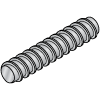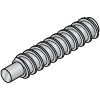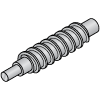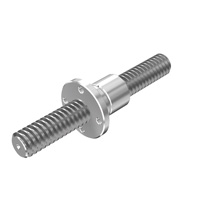(!) Since support from Microsoft will end on January 14 2020, Windows 7 user might not be able to use MISUMI website effectively. Please consider to update your system as ‘MISUMI Website system requirement’.
- แจ้งวันหยุดทำการในเดือน กรกฎาคมและสิงหาคม 2567 | Notice holiday in July and August 2024 > คลิก
THK Lead Screws, Nuts(Thread Position:Right-Hand Thread)
THK offers products Lead Screws, Nuts specified by Thread Position Right-Hand Thread from Automation Components product category. There are a total of 1 items. Search and select detailed specifications of parts for your machine with free CAD downloads. THK products are available to order through MISUMI online 24 hours a day. Free shipping, no minimum order.
Configure
Specification/Dimensions
-
Shaft Shape
-
 Straight
Straight -
 One End Stepped
One End Stepped -
 One End Double Stepped
One End Double Stepped -
 Both Ends Stepped
Both Ends Stepped -
 One End Stepped, One End Double Stepped
One End Stepped, One End Double Stepped -
 Both Ends Double Stepped
Both Ends Double Stepped
-
-
Nominal of Thread D(Ø)
-
Thread Position
- Right-Hand Thread
- Left-Hand Thread
- Right and Left-Hand Thread
- Precision Right and Left-Hand Thread
-
Thread Pitch(mm)
-
Shaft Material
- Steel
- Stainless Steel
-
Shaft Surface Treatment
- Not Provided
- Low Temperature Black Chrome Plating
- Black Oxide
-
Type
- Lead Screw
- Screw Nuts
-
Tolerance of Central Part (Incomplete Threaded Portion)
-
Screw Nut Shape
-
Screw Nut Material
-
Screw Nut Outer Dia. D(Ø)
-
Screw Nut Length L(mm)
Brand |
|
|---|---|
Filter By |
|
| CAD |
|
- 1 items
- Sort By
-
You can add up to 6 items per a category to the compare list.

 Until 31/03/2025
Until 31/03/2025 Until 31/03/2025
Until 31/03/2025Screw Nut, Screw Shaft, CS Type
THK
The nut and shaft are sold separately. Use THK nuts and shafts (DCM, DC, CS) as a set. No surface treatment is given to the cut shaft ends.
[Features]
· This DCM type and DC type screw nuts are 30° trapezoidal lead screws manufactured to comply with the applicable standards.
· The nut uses a special alloy and is die-cast molded with a precision male thread as its core.
· For this reason, it has less variation in accuracy than machined products, and is a bearing with high-accuracy and excellent abrasion-resistance.
· The combination screw shaft has been standardized through a rolling formation method.
· Improved abrasion-resistance: Cold rolled tooth shaft with tooth surface hardened to 250 HV or more and finished to a smooth mirror finish for superior abrasion-resistance. The combination of screw nuts provides extremely smooth movement.
· Improved mechanical properties: Because of the internal tooth structure of the rolled shaft, the fiber flow occurs along the tooth contours for tight rooted teeth with greater endurance strength.
· Alteration of shaft end support: The rolled shaft with altered shaft end support bearing part is easier to use in turning and milling.From: ฿ 605.00 Special Price Days to Ship: Same day
Same day
| Brand |
|---|
| Product Series |
| CAD |
| From |
| Days to Ship |
| Shaft Shape |
| Nominal of Thread D(Ø) |
| Thread Position |
| Thread Pitch(mm) |
| Shaft Material |
| Shaft Surface Treatment |
| Type |
| Tolerance of Central Part (Incomplete Threaded Portion) |
| Screw Nut Shape |
| Screw Nut Material |
| Screw Nut Outer Dia. D(Ø) |
| Screw Nut Length L(mm) |
You can add up to 6 items per a category to the compare list. | |
| Brand | THK |
| Product Series | |
| CAD |
|
| From | ฿ 605.00 Special Price On Sale Until 31/03/2025 |
| Days to Ship | Same day |
| Shaft Shape | Straight |
| Nominal of Thread D(Ø) | 12 ~ 50 |
| Thread Position | Right-Hand Thread |
| Thread Pitch(mm) | - |
| Shaft Material | Steel |
| Shaft Surface Treatment | Not Provided |
| Type | Screw Nuts |
| Tolerance of Central Part (Incomplete Threaded Portion) | Not Provided |
| Screw Nut Shape | Straight / Round Flanged |
| Screw Nut Material | Zinc Alloy |
| Screw Nut Outer Dia. D(Ø) | 22 ~ 58 |
| Screw Nut Length L(mm) | 22 ~ 70 |
Loading...
Application example related to this category
Related Categories to Lead Screws, Nuts
FAQ Lead Screws, Nuts
- Question: How do lead screws and ball screws differ in their applications and efficiency?
- Answer: Lead screws and ball screws differ in their applications and efficiency due to design variations. Lead screws, using a threaded shaft and nut, suit low-speed, low-precision tasks like manual adjustments. They typically exhibit lower efficiency due to higher friction. In contrast, ball screws integrate ball bearings between the screw and nut, enhancing efficiency, precision, and speed. Consequently, ball screws find favor in high-precision, high-speed applications such as CNC machining, robotics, and aerospace systems where smooth, precise motion is critical, offering superior performance compared to lead screws.
- Question: What should be considered when choosing the size of a lead screw for a specific application?
- Answer: When choosing a lead screw size for an application, consider factors like load capacity, speed, and precision requirements. Determine the necessary length, pitch, and lead based on travel distance and desired linear speed. Ensure proper end support and mounting arrangements to prevent instability. Also, consider environmental conditions, material choice, coating, and acceptable backlash levels. By carefully weighing these aspects, you can select the appropriate lead screw size to ensure optimal performance and reliability for your specific application.
- Question: What are the advantages of using a 30-degree trapezoidal lead screw with a double-end step?
- Answer: Using a 30-degree trapezoidal lead screw with a double-end step offers numerous benefits. These include enhanced load capacity, improved stability, reduced backlash for precise positioning, increased efficiency due to smoother operation, and versatility allowing for flexible design options utilizing both ends. Overall, this configuration provides strength, stability, precision, and adaptability, making it ideal for a wide range of industrial and mechanical applications requiring reliable and precise linear motion.
- Question: What distinguishes MiSUMi C-VALUE Lead Screws from standard MiSUMi products in terms of cost and quality?
- Answer: MiSUMi's C-VALUE Lead Screws offer a balance between cost-effectiveness and quality. They are priced lower than standard MiSUMi products, making them more affordable for applications where precision requirements are less stringent. While C-VALUE Lead Screws maintain a level of quality suitable for many applications, they may not offer the same level of precision and performance as standard products. This means they might have slightly looser tolerances or undergo less rigorous testing. However, they still provide a cost-effective solution for applications where moderate precision is acceptable.
- Question: What factors should be considered when selecting a lead screw for high-load applications?
- Answer: When selecting a lead screw for high-load applications, factors such as load capacity, material strength, diameter, pitch, nut design, and lubrication must be considered. The lead screw should withstand the anticipated load without deformation, requiring a material with high tensile strength and a robust nut design. A larger diameter and coarser pitch help distribute the load effectively, minimizing deflection. Proper lubrication reduces friction and wear, prolonging the lead screw's lifespan under high-load conditions, ensuring reliable performance in demanding applications.




















How can we improve?
How can we improve?